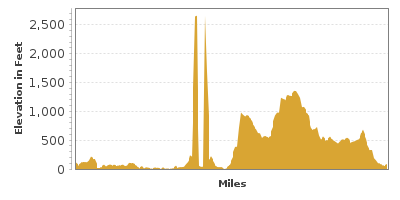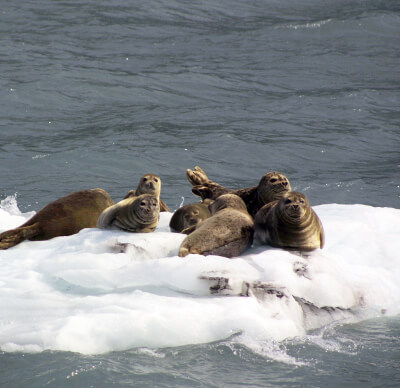Seward Highway
Through fjords and glaciers
| Mileage | 148 miles (238 km) |
|---|---|
| DurationThe duration is an estimate of a one-way drive and does not include any stops or side-trips. | 3 hours, 23 minutes |
| SeasonsThe seasons listed are the best seasons for this scenic drive. If Winter is not mentioned, the road may be closed during the winter. | Summer |
| Roadways | Alaska Highways 1 and 9, and Portage Glacier Road |
| ServicesThe cities or towns listed have either Food or Services such as gas, pharmacies, etc. | Anchorage, AK▼, Artesian Village, AK▼, DeBarr Vista, AK▼, Eagle River, AK▼, Rogers Park, AK▼, Spenard, AK▼, Girdwood, AK▼, Whittier, AK▼, more...Cooper Landing, AK▼, Moose Pass, AK▼, Tuomi, AK▼, Seward, AK▼, and Woodrow, AK▼ |
| Rating | 4.3 average from 24 votes |
| My DrivesTrack your favorite scenic drives by selecting those which you want to take and those that you have taken. Using your free account, simply sign in and select My Drives. | |
| Share |
Our free Road Trip Planner will reverse the route and include the places of interests. Click the “Add to Road Trip” above to start planning your next road trip.
Send this link to your phone. Standard text messaging rates apply.
() -Get directions from your start address to the beginning of and including this scenic drive. Choose either an alternate ending or same as start.
Have more destinations? Use our free Road Trip Planner to completely plan your adventure. Click the “Add to Road Trip” above to start planning your next road trip.

A great way to start a road tour of Alaska begins with flying into Anchorage, the largest city in the state. Anchorage sits on the edge of Turnagain Arm on Cook Inlet and at the base of the Chugach Mountains. Turnagain Arm was named by William Bligh of HMS Bounty, who served in Captain James Cook’s 1778 expedition to discover the Northwest Passage, after frustration in only finding a river

A blend of city comforts and extreme wilderness, Anchorage has a lot to offer. Explore Alaska’s history, art, science and Native American culture at the Anchorage Museum (M3). This modern facility houses a planetarium, Imaginarium Discovery Center, Smithsonian Arctic Studies Center and restaurant.
The Alaska Heritage Center (M2) shares the rich cultural life of Alaska’s 11 major native groups. Observe traditional native dances, carvers, listen to storytelling and tour replicas of dwellings.
If aviation is your passion, don’t miss the Alaska Aviation Heritage Museum (M1). Learn about Alaska’s aviation history and the pioneering bush pilots who helped open the last frontier.
Ground transportation in Alaska is limited to a few drivable roads and the Alaska Railway, making air travel the only other opportunity to reach far flung areas. Lake Hood in Anchorage is a Floatplane Base and is the world’s busiest seaplane base with upwards of 600 planes a day using the lake. Here you will find daily flights to remote fishing and hunting areas and photographic and wildlife excursions. The shoreline is packed with floatplanes of all ages and styles.
Kids and adults alike will enjoy Grizzly Junction home of Alaska Wildberry Park and Village. Walk the trail along Campbell Creek where wild berries grow and see reindeer. Watch the film, “Alaska, The Land Beyond” in the Wildberry Theater. Inside see the candy kitchen, the world’s largest chocolate waterfall, and of course partake in the delicious treats.
Downtown Anchorage is where you can find shops, restaurants, lodging, theaters, tour companies, visitor centers, and other tourist attractions. Winding around town and along Cook Inlet is the Tony Knowles Coastal Trail (H1). Beginning in Kincaid Park, you will quickly forget that you’re in a large city while walking the 11 paved miles. Look for beluga whales in the Inlet, moose in the forest, and explore Earthquake Park and its exhibits explaining the 1964, 9.2 magnitude earthquake that devastated the area.
Leaving Anchorage, drive to Seward Highway (AK-1). On the way, you will pass the ghost forest near the turnoff to Girdwood and then the crumbling abandoned structures of the town of Portage, both evidence of the earthquake devastation.
The Potter Point State Game Refuge (A1) is worth a stop. View and photograph the abundant waterfowl and migrating birds such as trumpeter swans, rednecked grebes, pintails, golden eyes via an easy stroll on the boardwalk.
Explore the Potter Section House Railroad Museum (M4) where model rail exhibits and archival photographs tell the story of the early railroad crews. Those interested can also ride a train to Whittier from here through the Whittier Tunnel (which this drive also goes to). This building also serves as the visitor center for the Chugach State Park (H3) which offers many trails to explore and spectacular views.
Chugach State Park and it’s half million acres of incredible nature await. Open year-round, summer offers river floating, wind surfing, horseback riding, or explore the more than 50 glaciers. Enthusiasts with small off-road vehicles are permitted on the Eklutna Lakeside and Bird Creek Trails Sunday to Wednesday. Winter is a haven for cross-country skiing, snowshoeing, dogsledding and skijourning — where you are towed on skis by dogs. Winter is also a great time for stargazing as night is non-existent in summer. Dress for extreme cold and be dazzled by bright stars and northern lights.
The Turnagain Arm Trail (H2) in Chugach State Park is just over nine miles long and an easy walk with great views. Here, extreme tidal changes called bore tides occur. A wall of water approximately six feet high comes rushing in at 15 miles per hour shortly after low tide. The mud flats all along this area are treacherous and walking on them is not advised. The State Park website hosts a tide schedule.
The road parallels Turnagain Arm. Take advantage of the many turnoffs and have camera in hand for sweeping panoramas. Beluga Point (V1) is a chance to observe Beluga whales as they fish for salmon. There are telescopes and interpretive panels explaining the life cycles of the whales and fish. At Windy Point (V2) look across the highway to spot Dall Sheep and Mountain goats that often feed near the edge of the highway. They can also be seen high above on the craggy cliffside. For a different vantage point of Turnagain Arm and Alyeska Glacier, consider a gondola ride at Alyeska Resort (A2).
Seward Highway brings you onto the Kenai Peninsula to the town of Seward with turnoffs for Soldotna, Kenai, and Homer. Before heading to Seward, take the Portage Glacier Road turnoff to Portage Lake and the Begich Bogg Visitor Center at Portage Glacier (V3). The Center used to directly face the massive blue-ice glacier, but shortly after it was built in 1986 the glacier began to drastically recede and is now around the corner at the end of the lake. Icy textures and shapes dominate the fantastic landscape and you will also see other glacial remnants including Explorer, Middle, Byron, Shakespeare and Burns Glaciers. Take a cruise to view Portage Glacier or the one-mile walk to the face of Byron Glacier along Byron Creek. Look closely and you will see ice worms. Picnicking, camping, hiking and fishing for trout are popular pastimes here. Because Portage Pass is a narrow land bridge between Turnagain Arm and Prince William Sound it can have very strong winds at times and weather can be unpredictable.
Next you will travel through the Whittier Tunnel, actually named the Anton Anderson Memorial Tunnel, the longest combined vehicle and railroad tunnel in North America extending 13,300 feet through Maynard Mountain. This is the only road access to the town of Whittier and Prince William Sound. Cars are allowed to drive over the railroad tracks at 15 minute intervals in summer from 5:30 a.m. to 11:15 p.m. Trips are computer scheduled, leaving Portage in one direction and then Whittier in the other. Trains can supersede the schedule at any time necessitating waiting periods.
At Whittier, there are many tour operators with cruises of varying length and price that allow you to experience the majesty of the glaciers, jagged cliffs, towering masses of ice, harbor seals lounging on ice floes called growlers and floating sea otters. Whales also frequent the Sound as well as seabirds.
Retracing your way back to AK-1 via the Whittier Tunnel, you will see scars of past avalanches on the mountainsides and gravel deposits dropped by passing glaciers.
The road follows Canyon Creek. In 33 miles from the Portage Lake turnoff, stop at Summit Lake (W1). Of the many lakes that line the road, none are more picturesque particularly when the wildflowers are in bloom. Take in the beauty of the glacially-carved terrain with a hike around the lake or on the bluff above. The bluff viewpoint is a popular launch site for paragliders and outstanding panoramic views.
Shortly afterwards, you arrive at Tern Lake (W2), a popular bird watching area surrounded by the Kenai Mountains. Here, turn left onto AK-9 towards Seward. You will pass Upper Trail Lake and Moose Pass until the road hugs the edge of glacier-formed Kenai Lake. On the southern end of the lake, enjoy some or all of the 14-mile the Lost Lake (H4) Trail.
If you have not yet seen a moose or beaver, the next section of the road may likely be your best chance. Paralleling Snow River, moose and beaver regularly enjoy a drink around here. You’ll also want your camera ready to capture the yellow pond lilies which are common during the summer months.
After the town of Bear Creek, consider a drive west on Exit Glacier Road to visit the Kenai Fjords National Park. The easy, one-mile round trip wheelchair accessible Glacier View Trail from the visitor center lead to a panoramic vista views of Exit Glacier. Those in for a more strenuous day hike, the 7.4-mile round trip Harding Icefield Trail leads to Harding Ice Field, North America’s third largest ice field. The glacier is so large that it consumes all but the highest peaks of the Kenai Mountains. The park also features boat tours, kayaking, fishing, ranger-led programs and winter activities such as snowmobiling and ice climbing.
Back on AK-9, the scenic drive comes to an end in the town of Seward. The downtown is quite pleasant to tour. Stop at the National Park Service Visitor Center in Seward (I3) to learn more about glaciers and the life that thrives around them. Or visit the Alaska SeaLife Center (A4), Alaska’s only aquarium and wildlife rescue center and a chance to see octopus, puffins, and sea lions up close. Culminate your trip with sweeping views of Resurrection Bay and the myriad of otters, whales, orcas and more that play here.
From here, either retrace your steps back to AK-1, where you can either return to Anchorage by heading east, or continue to explore the Kenai Peninsula, which including the Kenai National Wildlife Refuge (A3) which was established to conserve moose, bears, mountain goats and more. Open year-round, here you will find canoeing, fishing, hiking trails, wildlife viewing and camping and an array of winter activities.
Other Nearby Places of Interests
Begich Boggs Visitor Center (I1)
Exit Glacier Ranger Station (I2): From the Exit Glacier Ranger Station of Kenai Fjords National Park, a river of ice flows. An easy, one-mile round trip wheelchair accessible Glacier View Trail from the visitor center lead to a panoramic vista views of Exit Glacier. Those in for a more strenuous day hike, the 7.4-mile round trip Harding Icefield Trail leads to Harding Ice Field, North America’s third largest ice field. The glacier is so large that it consumes all but the highest peaks of the Kenai Mountains. The park also features boat tours, kayaking, fishing, ranger-led programs and winter activities such as snowmobiling and ice climbing.





